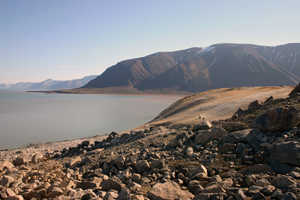Jotunkjeldene in Bockfjorden
[79° 20' N 13° 00' E]
By Øystein Overrein (ed.), Jørn Henriksen, Bjørn Fossli Johansen, Kristin Prestvold
Surrounded by glaciers and pointed mountain tops in the west, massive red sandstone mountains in the east and the Sverrefjell volcano in the south the Jotunkjeldene thermal springs are a geological «hot spot» in Svalbard.
 From the east and most developed of Jotunkjeldene. View to the north of Bockfjorden and outer part of Woodfjorden. Take care:
- Do not touch the thermal springs.
- Do not step on the carbonate deposits.
 The thermal springs have built up carbonate deposits that are very fragile to being stepped on, especially where the slopes are steep. This is why one must refrain from treading on the deposits and instead walk on the moraine soil along the sides. (Image: Bjørn Fossli Johansen / The Norwegian Polar Institute) The thermal springs have built up carbonate deposits that are very fragile to being stepped on, especially where the slopes are steep. This is why one must refrain from treading on the deposits and instead walk on the moraine soil along the sides. (Image: Bjørn Fossli Johansen / The Norwegian Polar Institute)
 At the top of the thermal springs, nature itself has cleared this space, the carbonate deposits having pushed the moraine soil to the side. Since the deposits are vulnerable, visitors are urged to tread on the moraine soil, and to use the stone circle around the deposits as a place to stand when admiring the view of the spring and the fjord. (Image: Jørn Henriksen) At the top of the thermal springs, nature itself has cleared this space, the carbonate deposits having pushed the moraine soil to the side. Since the deposits are vulnerable, visitors are urged to tread on the moraine soil, and to use the stone circle around the deposits as a place to stand when admiring the view of the spring and the fjord. (Image: Jørn Henriksen)
The two geothermal springs known as Jotunkjeldene lie at the bottom of Bockfjorden, close to the sea and at 50 m.a.s.l. They consist of large, terraced carbonate deposits, formed by minerals dissolved in the warm water on its way up through the bedrock. The water in the springs is groundwater that has been heated up so that the temperature at the surface is 20°C or more all year round. This can be linked to previous volcanic activity along a fault in the bedrock. At the top of the eastern formation there are two springs from which warm water emerges and runs down the front. In the western formation, there is no longer a spring at the top; rather, a spring emerges in the middle of the slope. Mosses and algae, not found elsewhere in Svalbard, thrive near the springs.
Trollkjeldene – a larger set of geothermal springs – can be found eight km further into the valley. The water temperature here has been measured at up to 28.3°C.
Vulnerable elementsThe carbonate deposits that have been built up by the springs are vulnerable and erode easily. Do not step on the deposits but walk on the surrounding moraine soil instead. Recommended trailsFollow the path from the landing site below the eastern spring, and get above the spring from one of the sides. Do not step on the carbonate deposits.
|